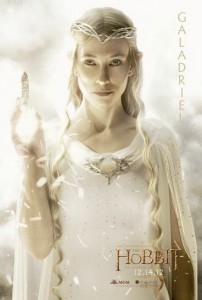Last time, the article series Women and Chauvinism in Middle-earth discussed the role of Eowyn and her relationship with Theoden. This time, I want to examine Galadriel as presented in the Lord of the Rings. I am aware that, in order to understand a character like Galadriel entirely, it is important to look at The Silmarillion, as well. However, my approach is to treat LOTR and The Silmarillion as two separate entities since they are two different sets of storytelling. First, I will try to analyse female characters in the Lord of the Rings individually and will then proceed with The Silmarillion.
In the Fellowship of the Ring in “The Mirror of Galadriel”, Galadriel is described as tall and beautiful, dressed in white and her hair “was of deep gold.” The first description of her appearance is one of a fair and beautiful being. The colour white, or women and white dresses, are commonly associated with light, innocence, or perfection. However, Galadriel’s eyes indicate that there is more to her than just beauty: “[…] no sign of age was upon [Galadriel and Celeborn], unless it were for the depths of their eyes; for these were keen as lances in the starlight, and yet profound, the wells of deep memory.” When reading the Lord of the Rings, one cannot deny that her persona evokes many different reactions. Not all of them being positive, despite the positive associations of her appearance. In Galadriel’s case, perceptions and hearsay becomes very important. My argumentation is that Galadriel and the effect she has on others, as represented in LOTR, is similar to her Mirror. When thinking of mirrors one assumes that a mirror only shows reflections of what is really there. That is not the case with Galadriel’s Mirror; people can see many things in her Mirror. In the the chapter “the Mirror of Galadriel,” Frodo and Sam are warned:
“What you will see, if you leave the Mirror free to work, I cannot tell. For it shows things that were, things that are and things that yet may be […] the Mirror shows many things, and not all have yet come to pass. Some never come to be, unless those that behold the visions turn aside from their path to prevent them. The Mirror is dangerous as a guide of deeds.”
Of course, Galadriel’s advice and guidance for the Fellowship are not deceiving and dangerous. However, depending on the race and region in Middle-earth, Galadriel’s reputation and the things being projected onto her persona and realm differ widely. Since Lothlorien is unknown to many, these different reactions represent the deep rooted fear of the unknown. Once such example takes place in the conversation between Aragorn and Boromir in the chapter “the Mirror of Galadriel.” Boromir continues to distrust Galadriel even after he met her: “I do not feel too sure of this Elvish Lady and her purposes.” “Speak no evil of the Lady Galadriel!” said Aragorn sternly. “You know not what you say. There is in her and in this land no evil, unless a man bring it hither himself.” For Boromir, Galadriel and her realm are unknown, and the only things he heard were negative. Aragorn, on the other hand, has been in Lothlorien and knows its true nature. One of the things that seems to evoke fear is Galadriel’s ability to look into a person’s mind:
“Stray but a little and it will fail, to the ruin of all. Yet hope remains while the Company is true.” And with that word she held them with her eyes, and in silence looked searchingly at each of them in turn. None save Legolas and Aragorn could long endure her glance. Sam quickly blushed and hung his head. At length the Lady Galadriel released them from her eyes, and she smiled […] Then they sighed and felt suddenly weary, as those who have been questioned long and deeply, though no words had been spoken openly.
Anne C. Petty argues in her book One Ring to bind them all: Tolkien’s Mythology that Galadriel “may possess menacing powers as well as benevolent intentions, and in this capacity acts as temptress to separate members of the Fellowship and to the company’s purpose as a whole.”
Sometimes Galadriel is referred to as “the Lady of the Wood,” other times she is called a “sorceress of the Golden Wood.” In other words, the assumed negative characteristics people project onto her are diverse. In Gondor and Rohan, Galadriel and her realm are widely known as a place where “few come out who once go in; and of that few none have escaped unscathed,” at least that’s what Faramir’s and Eomer’s claims indicate.
Faramir: “If Men have dealings with the Mistress of Magic who dwells in the Golden Wood, then they may look for strange things to follow. For it is perilous for mortal men to walk out of the world of this Sun, and few of old came thence unchanged, ’tis said.”
Maybe these negative connotations are based on gender, since Galadriel is, at that time, the only women with a power to rule. Maybe it has something to do with the negative perceptions of witches and sorceress in contrast to wizards which can be seen as another issue based on gender.
However, when reading Lord of the Rings one also has to keep in mind that many times characters, mostly Aragorn or Gimli, come to her “defence.” I use the word “defence” for the lack of a better word, because most of the time, people spoke ill when Galadriel was absent. Most haven’t met her and rooted their opinion on hearsay. Aragorn and Gimli make clear not to speak ill of her since the negative perceptions of her are wrong. The impact Galadriel has on Gimli is a good example how her perceived “menacing powers” don’t just evoke negative feelings.
She looked upon Gimli, who sat glowering and sad, and she smiled. And the Dwarf, upon hearing the names given in his own ancient tongue, looked up and met her eyes; and it seemed to him that he looked suddenly into the heart of an enemy and saw there love and understanding. Wonder came into his face, and then he smiled in answer.
Later on, Gimli is totally in awe. He asks her for a single strand of her hair “to treasure it and to pledge good will between the Mountain and the Wood until the end of days.” And she gives him three.
Of course, there is so much more to say about Galadriel in LOTR alone, such as her role as a female leader, her wisdom and attitude towards Gimli, and so on. An analysis of The Silmarillion sheds another light on her character. One other very interesting interpretation angle I came across is by Anne C. Petty. According to her, Galadriel and Shelob are “both manifestations of the dread power of the female nature, yet binary opposites in Tolkien’s conception.” She argues in her book One Ring to bind them all: Tolkien’s Mythology that “[Shelob] relies on the power of darkness for the purposes of malice, yet is as necessary to the balance of the natural world of Middle-earth as the elvish queen’s uplifting powers of light. […] The pitch of Shelob’s lair provides a direct contrast to the light of Galadriel […].” Personally, I’ve never thought about Galadriel and Shelob that way, but it is a very interesting approach. Therefore, next time I will try to examine Shelob and see if, or to what degree, Galadriel and Shelob really are two binary opposites.





Pingback: Middle-earth News – Women and Chauvinism in Middle-Earth: Shelob